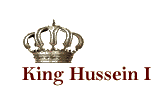 |
|
 |
|
The Royal Court compound is called the Maqar (headquarters). The offices and palaces were established there because the armies of the Arab revolt camped there when they liberated Amman in 1918. When the Monarchy was established in Jordan during the early 1920’s, Emir (later King) Abdullah took up temporary residence in a small building in central Amman close to the Roman amphitheater. It was later decided that the Royal Court should move to a more suitable area. The Court now lies on a hill in the old sector of Amman, close to the railway station near Amman’s Marka Airport. This is what is known today as the Royal Palaces, the property of the Crown. Construction on the site began in 1925. Raghadan Palace was the first to be built in the new compound. King Abdullah used to refer to Raghadan as the "big one". Later, a second smaller house was built, to which the King referred to as "the little one", or at times, "the middle one". A third, was referred to as the "top one" – or, to go by its proper name, Al-Ma’wa, meaning literally, the "Sanctuary". The Court now encompasses many older buildings that were constructed during the early reign of His Majesty King Abdullah, which were used as living quarters for the King as well as other members of the Royal Family. Notably at that time, quarters used by the British Resident were very close. That same building is today used as the home of Their Royal Highnesses Prince El Hassan and Princess Sarvath. |
The word Raghadan originates from the Arabic verb, "raghad" to reflect a comfortable life. When Raghadan was built in 1926, it cost £1,600 to build. Stones from the southern town of Ma’an were used for the exterior. Its windows were made from colored glass to resemble the al-Aqsa Mosque in Jerusalem. The wood work in the palace generally and the Throne Hall in particular was of exceptional beauty. It became the home of King Abdullah and his family, and was also used as offices for the Royal Court. |
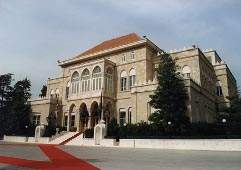 |
||
It underwent some renovation over the years, the latest was to take place during the late 1980’s following a fire that destroyed the roof in 1983. The latest restoration and expansion were comprehensive. It included new flooring in the Throne Hall and to several other rooms. In particular, the former ceiling fresco in the Throne Hall depicting Islamic art was remade to its original beauty and the same Islamic architectural features of the original building as well as the exterior outlook were all preserved. A special galleried area on the ground floor, which came to be known as "al-Maqqar al-A'la", meaning, a form of a sublime sanctuary, was used by King Abdullah for prayers, solitude and reflection, and remains preserved as such to this day. Today, Raghadan Palace contains one of the most important rooms of the Crown properties. The most distinguished is the Throne Hall, which is used for state occasions, such as when the King receives good wishes from dignitaries and the general public during Eid al-Fitr and Eid al-Adha. It is also used when His Majesty accepts credentials of new ambassadors, and for receiving members of the Senate and the Lower House, to deliver their replies to His Majesty’s Speech at the State Opening of Parliament. The palace also houses some of the official gifts that have been presented to King Hussein and the Hashemite family. Additionally, the palace serves as a primary location for working meetings between the King and visiting heads of states and dignitaries. Raghadan is located within the Royal Court compound. |
|||
|
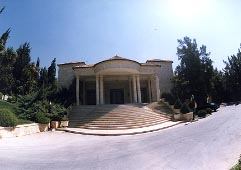 |
The word Basman originates from the Arabic verb which means to be joyful. Construction of Basman Palace began under King Abdullah in 1950. It was designed as a guest reception palace, additional working offices for the Royal Court, and a private wing for King Abdullah. However, part of Basman became the private living quarters of His Majesty King Hussein in the early fifties before it entirely became the working offices of the Royal Court. This came to be known as al-Diwan al-Malaki, the Royal Court. |
| The building underwent some
renovation and expansion over the years. During the early 1980’s, a new official
banquet hall and a reception area were renovated on the western part of Basman as well as
a new meeting room to the eastern section, yet preserving the same architectural beauty of
the building. Today, the building contains His Majesty King Abdullah’s offices, as well as offices for His Royal Highness Prince Muhammad and His Royal Highness Prince El Hassan. Prince El Hassan’s office was used for a short time by King Abdullah before his death in July 1951. Basman is also used by the main officials of the Royal Court. Basman Palace is located within the Royal Court compound. |
|
In English, this would be the "Little Palace". It is situated a few steps to the north of Raghadan Palace and was built in the 1930s for the use of the then Crown Prince Talal (later King) and Princess Zein al-Sharaf. Their first child, Prince (later King) Hussein was born in this building. Following the latest renovation of Raghadan, this building was used in 1990 to accommodate the Royal Commission for drafting the National Charter. It was also used as working offices for His Majesty the late King Hussein and some officials of the Court. Most recently, it held the offices of the National Security Council. Al-Qasr al-Sagheer is located within the Royal Court compound. |
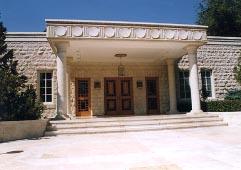 |
|
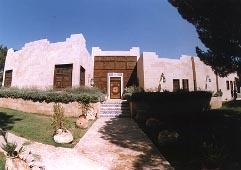 |
Al-Ma’wa, or the "Sanctuary" was also built during the 1930’s. Al-Ma’wa, or "the top one" as it was referred to, was used by King Abdullah to receive representatives of Jordanian tribes every Friday. In 1979, al-Ma’wa became working offices for Her Majesty Queen Noor. It was renovated and expanded during the mid 1980’s.
|
||
| Al-Ma’wa is located within the Royal Court compound. | |||
|
Bab As-Salaam, or "the Gate of Peace," was the final home of His Majesty King Hussein. Her Majesty Queen Noor continues to live there today. It was named after one of the entrances to Al-Haram al-Sharif, or "the Great Mosque" in Mecca. Bab As-Salaam is located within the Hummar area, a short distance to the northwest of Amman. |
 |
|
 |
The Arabic for Nadwa means "the assembly expanse". Nadwa was the private home of His Royal Highness Prince Nayef Bin Abdullah. In 1980, it was renovated to become the home of Their Majesties King Hussein and Queen Noor, and remained so until their move to Bab As-Salaam. Nadwa is today a guest palace. It is located in the Royal Court compound in central Amman. |
|
Located on high ground in the Hummar area, the Palace was built during the mid 1970s to be the home of Their Majesties King Hussein and Queen Alia, until the Queen’s tragic death on February 9, 1977. From the palace, Jerusalem could easily be seen on a clear day. In appreciation of Queen Alia’s love for this beautiful area, she was laid to rest close by the Palace and a mosque was built nearby. |
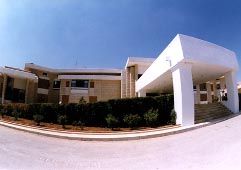 |
||
During the 1980’s and until 1997, al-Hashmiya was used as a guest palace for visiting heads of state and dignitaries, when Their Majesties King Hussein and Queen Noor asked for the building to become a new home for some 200 orphans who were living in harsh conditions in Amman. The Palace took the name of Dar al-Bir. |
|||
|
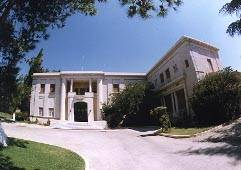 |
The word Zahran originates from the Arabic which means a blooming flower. Zahran Palace was built during the 1950’s. It was the home of Her Majesty the late Queen Zein al-Sharaf, the mother of His Majesty the late King Hussein. Zahran is located close to the Third Circle on Jabal Amman, and overlooks a beautiful boulevard where other older buildings are still used as embassies. |
|
The Palace was named after an Ummayad hunting lodge south of Amman. Located in the Jordan Valley near the town of southern Shuna and the Dead Sea, King Abdullah used to live and work here during the winter months. It was built in 1929 and was renovated in 1942, after which the Palace became a guest house for Prince Abdel Ilah, the Regent of Iraq. King Hussein continued to use it as a working farm and country home until the June 1967 war. On March 21, 1968, it was damaged by the Israeli army during the Battle of Karama. Today, it is still a working farm. |
|
Located in the Royal Court compound, this is
where King Hussein, King Abdullah, King Talal and Queen Zein al-Sharaf rest. Also in the
Royal Cemetery rest members of the royal family; the sharifs (nobles), and several Prime
Ministers. |